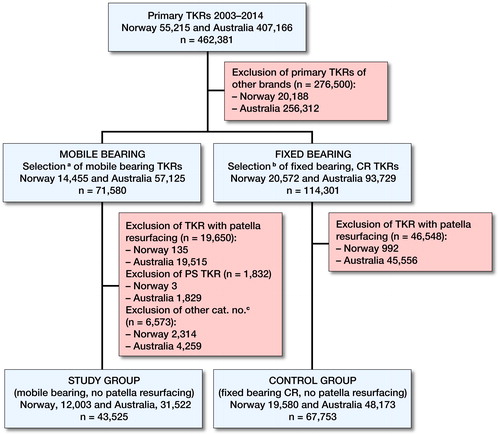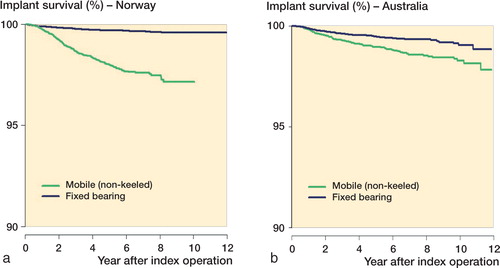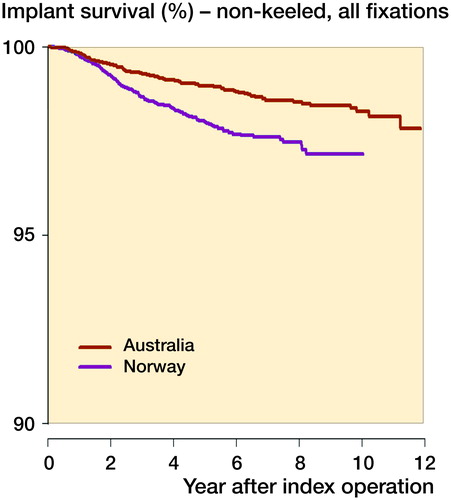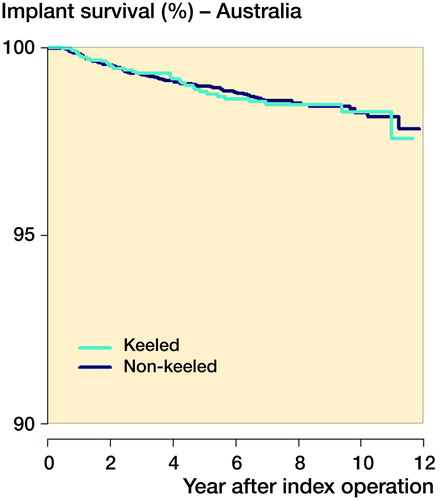Figures & data
Figure 1. Selection of study and control groups from the Norwegian and Australian joint replacement registries, 2003–2014.
aMobile-bearing brands (LCS and PFC Sigma).
bFixed-bearing cruciate-retaining brands, 3 most used in Norway (Profix, NexGen, AGC) and in Australia (Triathlon, NexGen, PFC Sigma).
cOther tibial component catalogue numbers than 12943 and 9003.
TKR = total knee replacement. CR = cruciate retaining. PS = posterior stabilized.
Cat. no. = catalogue number.

Table 1. Demographics of included primary TKRs in Norway and Australia
Figure 2. Kaplan–Meier curves with aseptic loosening as end-point. Mobile-bearing rotating-platform knees compared with fixed-bearing knees in Norway and Australia. (a) Mobile-bearing rotating-platform non-keeled knees (all fixations, without patella resurfacing) compared with the three most used fixed-bearing cruciate-retaining knees (all fixations, without patella resurfacing) in Norway. (b) Same selection criteria as above applied to Australian data.

Table 2. K–M survival (not revised due to aseptic loosening) by LCS Complete tibial design and fixation method, of primary cruciate-retaining TKRs without patella resurfacing, reported to the Norwegian and Australian joint replacement registries between 2003 and 2014. K–M survival estimate was not calculated when median follow-up was less than a year, number of patients in the group was less than 100, or when number of patients at risk was less than 50. Relative risk (RR) for aseptic loosening estimated by Cox regression analysis adjusting for age, sex, and preoperative diagnosis, RR1 with Australian non-keeled as reference, RR2 with reference to country-specific control group (3 most used fixed bearings).
Table 3. 10-year K–M survival data for revision due to aseptic loosening for the control groups, i.e. the 3 most common fixed bearing implants in each country
Figure 3. Kaplan–Meier curves with aseptic loosening as end-point. Mobile-bearing rotating-platform non-keeled knees (all fixations, without patella resurfacing) in Norway and Australia, a comparison between countries.

Figure 4. Kaplan–Meier curves with aseptic loosening as end-point. Mobile-bearing rotating-platform non-keeled compared with keeled knees within Australia (Australian data only).

Table 4. 10-year K–M survival data and relative risk (RR) estimates by Cox regression analysis adjusting for age, sex, and preoperative diagnosis for revision due to any reason
Table 5. Number of revisions (n) by country and specified revision diagnosis, for the non-keeled mobile-bearing LCS Complete, hierarchical order from top to bottom. Values are number and percent of revisions
